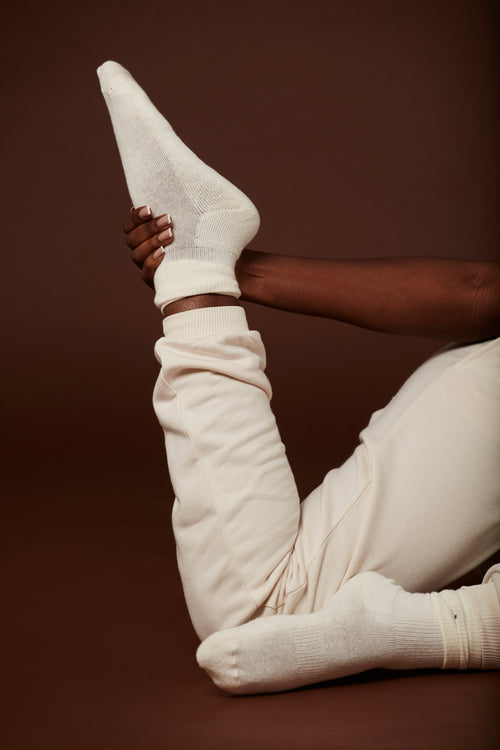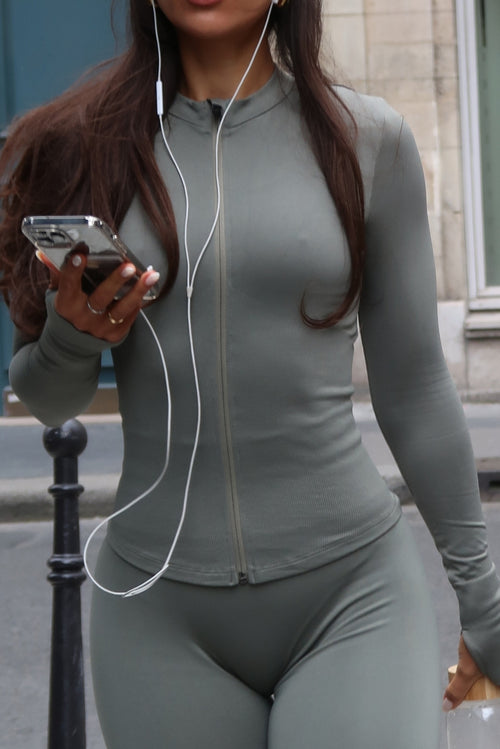Have you ever showed up to the gym only to realise your shirt is see-through when you start sweating or your leggings keep sliding down during your workout? We've all made mistakes when it comes to what we wear for exercise. But some fashion faux pas are more common than others.
Before your next trip to the gym, check out this list of the top five gym clothing mistakes you're probably making and how to fix them. You'll be able to focus on your fitness goals instead of constantly adjusting your outfit. With the right athletic wear, you'll move better, feel more confident, and avoid unwanted stares from the guy on the treadmill behind you.
1. Wearing the Wrong Fabrics - Gym Clothing Mistakes
Wearing the wrong fabrics in the gym is one of the biggest mistakes women make. Cotton may seem comfortable, but once you start sweating, it clings to your body and feels heavy. Synthetic fabrics like polyester or nylon are better options for exercise clothing. These materials are lightweight, moisture-wicking, and breathable. They keep you feeling fresh during your workout.

Spandex or elastane are also great for exercise gear. They provide stretch so your clothing moves with you. Look for fabrics with a high percentage (at least 87%) of polyester or nylon and a bit of spandex for stretch. These specialised performance fabrics, like Dri-Fit or ClimaCool, are designed specifically for exercise and will keep you comfortable and dry.
Avoid silk, rayon, or wool fabrics for the gym. While lovely for lounging, they won't wick moisture away from your body. Cotton t-shirts and shorts will get soaked in sweat during an intense workout leaving you feeling overheated and weighed down. Proper layering with thermal undergarments can keep you warm without the bulk.
The gym is not the place for your favourite cotton tee or loose silk shorts. Invest in high-performance fabrics that will endure your toughest workouts. Your body will thank you, and you'll get more out of your exercise knowing your clothing can keep up with you. The right fabrics make all the difference in having a successful gym session.
2. Choosing Fashion Over Function - Womens Sports Clothing Mishaps
Choosing fashion over function is one of the biggest mistakes women make with their gym clothing. Sure, you want to look good while working out, but your top priority should be choosing activewear for women made specifically for exercise.
Athleisure wear may be comfortable and on-trend, but it likely won’t stand up to intense activity. Look for clothing made of moisture-wicking, breathable fabrics like polyester or nylon blends. These help keep you dry and prevent overheating. Avoid cotton - it absorbs sweat and stays damp against your skin.
For weight training in particular, opt for gym wear for women that offers support. Sports bras that compress and lift are a must for comfort and confidence when doing exercises like running or plyometrics. Tight-fitting tank tops and t-shirts also prevent excess movement.
Don't forget that gym pants or leggings should be stretchy but not constricting. Look for options with a high percentage of spandex that move with your body. Leggings that are too tight can limit your range of motion and even lead to pulled muscles.
At the end of the day, the most important thing is that you can move freely in your activewear. While being fashionable at the gym is great, focus first on function and comfort. Your workout and your body will thank you. After all, you can’t achieve your fitness goals if your clothing is holding you back!
3. Not Prioritising Support - Weight Lifting Outfit
When weight training, the most important part of your gym outfit is a supportive sports bra and comfortable shorts or pants.
A high-impact sports bra is essential for any cardio or weight lifting. An ill-fitting bra won’t properly support your breasts during exercise and can lead to pain, discomfort and even injury. Look for a bra specifically designed for high-intensity workouts that encapsulate each breast to limit excess movement. Compression crops or tops can also help support your core muscles during weight lifting.
For bottoms, fitted gym shorts, leggings or sweatpants are good options. Loose or baggy shorts can get in the way of equipment and limit your range of motion. Leggings provide light compression and wick away sweat to keep you comfortable. If you prefer looser pants, tie the waist string to avoid them slipping down during activity.
Proper athletic shoes are also important for weight lifting. Cross trainers or weight lifting shoes provide stability and support for lifting heavy weights. Running or walking shoes typically don’t have the flat, rigid sole you need and can negatively impact your form and performance.
By focusing on a highly supportive sports bra, fitted bottoms and proper weight lifting shoes, you’ll get the most out of your gym sessions and avoid injury. Don’t make the mistake of wearing old t-shirts, yoga pants and running shoes - your body and your workout will thank you for investing in purposeful athletic wear. When you look good, you feel good and will have the confidence and comfort to push yourself further.
4. Ignoring Fit - Gym Wear for Women

When it comes to your gym outfit, an improper fit is one of the biggest mistakes you can make. Ill-fitting clothing can be uncomfortable, restrict your movement, and in some cases even cause injury.
Size Matters
Make sure you buy activewear in the proper size for your body. Clothing that is too tight can cut off circulation, chafe your skin, and limit your range of motion. On the other hand, loose or baggy clothing can get caught on equipment and also hamper your workout. Buy gym clothes that fit snug but still allow you to move freely.
Support is Key
For certain exercises like running, high-impact aerobics or weight training, you need clothing that provides adequate support. Look for sports bras, tanks and leggings made of performance fabrics like nylon, polyester and spandex that wick away moisture and provide compression. Compression gear in particular helps support your muscles during activity. Make sure any straps, waistbands or leg openings don't dig into your skin.
Length Check
Pay attention to the length of shorts, tops and leggings. Shorts that are too short can ride up while exercising and be uncomfortable. Tank tops or shirts that are too long will get in the way of free movement. For most activities, aim for shorts with an inseam of 3 to 5 inches, and tops that hit around hip-length. Leggings should reach to your ankle for yoga or other bendy workouts.
Consider the Activity
Choose gym clothes suited to your specific activity. Yoga pants or leggings and a fitted top are great for yoga or Pilates. Moisture-wicking tanks and shorts are ideal for cardio or HIIT classes. For weight lifting outfit, you want flexible leggings or shorts and a supportive sports bra. Make sure whatever you wear is also appropriate for the gym environment. Your fellow members will thank you!
Following these tips will ensure your gym outfit supports you properly and allows you to work out safely and comfortably. When your clothing fits well and suits your needs, you can focus on your workout rather than what you're wearing.
5. Skipping Proper Laundering - Activewear for Women
Activewear for women is designed for intense workouts, so it's bound to get smelly after a few wears. However, just throwing your gym clothes in the wash isn't enough. To prevent odours and keep your athletic apparel in good shape, be sure to properly launder your activewear after 2-3 wears.
First, pretreat any stains before washing. For protein stains like sweat, use a stain remover with enzymes or ammonia. For deodorant marks, scrub with a paste of water and baking soda.
Next, wash workout clothes separately from regular laundry in warm or hot water. This will kill more bacteria and prevent odours from transferring to your other clothes. Use a sports detergent which contains odour-fighting ingredients, or add a cup of white vinegar to a normal detergent. The vinegar will naturally deodorise and brighten your athletic wear.
After washing, avoid fabric softener which can coat fibres and prevent moisture wicking. Instead, add a half cup of white vinegar to the rinse cycle. The vinegar will soften clothes without reducing breathability.
For the drier, low or no heat is best. High heat can damage technical fabrics and cause clothes to wear out faster. Remove clothes while they're still slightly damp to prevent over-drying. This keeps stretchy fabrics from becoming misshapen.
Finally, avoid bleaching performance apparel whenever possible. Only non-chlorine bleach or oxygen bleach should be used sparingly. Bleach wears down fibers, fades colours and reduces the lifespan of your gym clothes.
Proper laundering after each wear is key to keeping your gym clothes odour-free and in top shape. Follow these tips and your athletic apparel will stay fresh, retain its shape and last longer. No more smelly workout clothes - your nose and wallet will thank you!
Conclusion
So there you have it, the top five gym clothing mistakes you've probably been making and didn't even realise. Now that you're in the know, you can make some easy fixes and upgrades to your workout wardrobe. Investing in high-quality, wellfitting gear made specifically for exercise will make you feel more comfortable and confident, allowing you to focus on your fitness goals.
And remember, what you wear to the gym, or don't wear, says a lot about your motivation and commitment. Make sure you're putting your best foot forward, even when you're working up a sweat. Stay stylish, stay dedicated, and keep pumping that iron, girl! You've got this.




